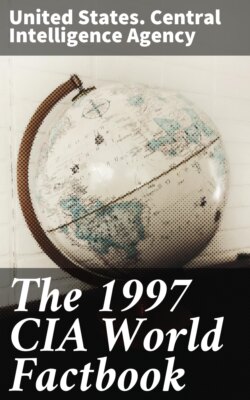Читать книгу The 1997 CIA World Factbook - United States. Central Intelligence Agency - Страница 28
На сайте Литреса книга снята с продажи.
ОглавлениеDiplomatic representation from the US: chief of mission : Ambassador Genta Hawkins HOLMES embassy: Moonah Place, Yarralumla, Canberra, Australian Capital Territory 2600 mailing address: APO AP 96549 telephone: [61] (6) 270–5000 FAX: [61] (6) 270–5970 consulate(s) general: Melbourne, Perth, and Sydney
Flag description: blue with the flag of the UK in the upper hoist-side quadrant and a large seven-pointed star in the lower hoist-side quadrant; the remaining half is a representation of the Southern Cross constellation in white with one small five-pointed star and four, larger, seven-pointed stars
Economy
Economy - overview: Australia has a prosperous Western-style capitalist economy, with a per capita GDP above the levels in highly industrialized West European countries. Rich in natural resources, Australia is a major exporter of agricultural products, minerals, metals, and fossil fuels. Commodities account for about 60% of the value of total exports, so that a downturn in world commodity prices can have a big impact on the economy. The government is pushing for increased exports of manufactured goods, but competition in international markets continues to be severe. Australia has suffered from the low growth and high unemployment characterizing the OECD countries in the early 1990s, but the economy has expanded at reasonably steady rates in recent years. In addition to high unemployment, short-term economic problems include a balancing of output growth and inflationary pressures and the stimulation of exports to offset rising imports.
GDP: purchasing power parity - $430.5 billion (1996 est.)
GDP - real growth rate: 3.6% (1996 est.)
GDP - per capita: purchasing power parity - $23,600 (1996 est.)
GDP - composition by sector: agriculture: 3.1% industry: 27.7% services: 69.2% (1994)
Inflation rate - consumer price index: 3.1% (1996 est.)
Labor force: total: 8.4 million (December 1996) by occupation : finance and services 34%, public and community services 23%, wholesale and retail trade 20%, manufacturing and industry 17%, agriculture 6% (1987 est.)
Unemployment rate: 8.5% (1996 est.)
Budget: revenues: $95.69 billion expenditures : $95.15 billion, including capital expenditures of $NA (FY95/96 est.)
Industries: mining, industrial and transportation equipment, food processing, chemicals, steel
Industrial production growth rate: 1.2% (1995)
Electricity - capacity: 38.83 million kW (1994)
Electricity - production: 173 billion kWh (1995)
Electricity - consumption per capita: 8,278 kWh (1995 est.)
Agriculture - products: wheat, barley, sugarcane, fruits; cattle, sheep, poultry
Exports: total value: $59.5 billion (f.o.b., 1996) commodities : coal, gold, meat, wool, alumina, iron ore, wheat, machinery and transport equipment partners: Japan 24%, South Korea 8%, NZ 7%, US 7%, UK, Taiwan, Singapore, Hong Kong (1994/95)
Imports: total value : $59.7 billion (f.o.b., 1996) commodities: machinery and transport equipment, computers and office machines, telecommunication equipment and parts; crude oil and petroleum products partners: US 22%, Japan 17%, UK 6%, China 5%, NZ 5% (1994/95)
Debt - external: $134 billion (June 1996)
Economic aid: donor: ODA, $1.25 billion (FY95/96)
Currency: 1 Australian dollar ($A) = 100 cents
Exchange rates: Australian dollars ($A) per US$1 - 1.2835 (January 1997), 1.2773 (1996), 1.3486 (1995), 1.3668 (1994), 1.4704 (1993), 1.3600 (1992)
Fiscal year: 1 July - 30 June
@Australia:Communications
Telephones: 8.7 million (1987 est.)
Telephone system: good domestic and international service domestic: domestic satellite system international: submarine cables to New Zealand, Papua New Guinea, and Indonesia; satellite earth stations - 10 Intelsat (4 Indian Ocean and 6 Pacific Ocean), 2 Inmarsat (Indian and Pacific Ocean Regions)
Radio broadcast stations: AM 258, FM 67, shortwave 0
Radios: NA
Television broadcast stations: 134 (1987 est.)
Televisions: 9.2 million (1992 est.)
@Australia:Transportation
Railways: total : 38,563 km (2,914 km electrified; 172 km dual gauge) broad gauge: 6,083 km 1.600-m gauge standard gauge: 16,752 km 1.435-m gauge narrow gauge: 15,728 km 1.067-m gauge
Highways: total : 895,030 km paved: 345,482 km (including 1,330 km of expressways) unpaved: 549,548 km (1995 est.)
Waterways: 8,368 km; mainly by small, shallow-draft craft
Pipelines: crude oil 2,500 km; petroleum products 500 km; natural gas 5,600 km
Ports and harbors: Adelaide, Brisbane, Cairns, Darwin, Devonport,
Fremantle, Geelong, Hobart (Tasmania), Launceton (Tasmania), Mackay,
Melbourne, Sydney, Townsville
Merchant marine: total: 69 ships (1,000 GRT or over) totaling 2,282,084 GRT/3,326,092 DWT ships by type : bulk 30, cargo 4, chemical tanker 3, combination bulk 1, container 5, liquefied gas tanker 4, oil tanker 14, roll-on/roll-off cargo 7, short-sea passenger 1 (1996 est.)
Airports: 443 (1996 est.)
Airports - with paved runways: total: 275 over 3,047 m : 9 2,438 to 3,047 m: 13 1,524 to 2,437 m: 106 914 to 1,523 m: 116 under 914 m : 31 (1996 est.)
Airports - with unpaved runways: total: 168 1,524 to 2,437 m: 22 914 to 1,523 m: 146 (1996 est.)
Military
Military branches: Australian Army, Royal Australian Navy, Royal
Australian Air Force
Military manpower - military age: 17 years of age
Military manpower - availability: males age 15–49 : 4,863,007 (1997 est.)
Military manpower - fit for military service: males: 4,200,090 (1997 est.)
Military manpower - reaching military age annually: males: 127,508 (1997 est.)
Military expenditures - dollar figure: $7.9 billion (FY96/97)
Military expenditures - percent of GDP: 1.9% (FY96/97)
Transnational Issues
Disputes - international: territorial claim in Antarctica (Australian
Antarctic Territory)
Illicit drugs: Tasmania is one of the world's major suppliers of licit opiate products; government maintains strict controls over areas of opium poppy cultivation and output of poppy straw concentrate ______________________________________________________________________
